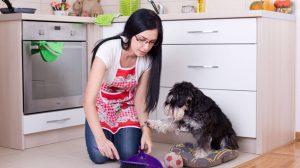The dog is man’s best friend, but sometimes four-legged friends bond too closely to their master or mistress. Separation anxiety becomes impossible to leave the pet alone without showing tangible signs of stress, anxiety, and fear. However, these symptoms can indicate separation anxiety and other problems.

Separation anxiety is usually noticeable in dogs through some behavioral issues: As soon as the loved one is about to leave the house, the affected four-legged friends show symptoms of stress. However, it would help if you did not make this diagnosis hasty and without advice from the veterinarian. If you misinterpret the behavior of your protégé, you cannot help him when in doubt.
Separation Anxiety Symptoms: Beware of misunderstandings
When dogs suffer from separation anxiety, the fear can be related to the absence of a specific person or being alone. The affected dog shows problematic, sometimes dangerous behavior as symptoms as soon as the fear-triggering situation arises or is announced.
Separation anxiety can manifest itself to varying degrees: in mild cases, the four-legged friend can withstand his fears for a certain amount of time; in severe cases, he goes nuts if the feared situation announces itself even subtly.
Dogs that generally cannot be left alone can usually be soothed by a peer, a dog sitter, or placed in a boarding kennel where they can have company. Four-legged friends, who are only fixated on a particular favorite person and suffer from separation anxiety, usually cannot bear a moment without this person.
The following behavioral problems are typical symptoms of separation anxiety:
● “Destruction Rage”: pillows, newspapers, papers, shoes, furniture, plants are bitten and torn; Doors and window frames are scratched
● Constant barking, yelping, and whining
● Uncleanliness, housebreaking is forgotten
● Coprophagia: Dog eats feces or other inedible things
● Stereotypical behavior: Pet is pacing or turning in circles
● Attempts to escape, sometimes resulting in injury, when the four-legged friend is alone in a room or his kennel
● Symptoms of stress and anxiety: dilated pupils, heavy panting, excessive soothing signals
These signs are only symptoms of separation anxiety if they occur solely in the context of the situation that triggers the fear. When the dog is no longer alone, or its favorite person is present, it calms down again, and the behavioral problems subside.
If this is not the case, another problem is hiding behind the unwanted or strange behavior. Your pet can tolerate your absence but shows “destructiveness” or uncleanliness when it is alone, which can also be due to boredom. Check whether your dog has enough opportunities to work and rest without being entertained by its people, whether physically and mentally busy in general, according to its breed, personality, and temperament, without being overwhelmed.
Separation anxiety or not? Better to go to the vet first
It may be that the apparent separation anxiety symptoms indicate another health issue. Dogs instinctively try not to show weakness or pain when ill, so signs of illness and injury often seem cryptic and subtle.
The four-legged friends then try to get your attention to let you know that something is wrong – and this is often most effectively done through conspicuous behavior. So your first step should you take a trip to the vet if you notice any significant changes in behavior so that they can hopefully rule out an organic cause for the problems.
Suppose everything seems to be in order physically; if your dog is being used to its species-appropriate level and if you can rule out mistakes in dog training with certainty, separation anxiety is likely. In severe cases and if you do not have the confidence to tackle your four-legged friend’s mental problems, seek help from an animal psychologist or a dog trainer trained in dog psychology.
Possible causes of separation anxiety in dogs
Some dog breeds are thought to have a certain predisposition to developing separation anxiety. That doesn’t mean that they always and always get an anxiety disorder, but they are more prone to it. This applies particularly to breeds bred to be good and loyal partners to humans – for example, when hunting. Dogs such as the German Shorthaired Pointer, Cocker Spaniel, or the Vizsla are therefore considered to be predisposed in this regard. But even companion dogs and “lapdogs” such as the Bichon Frisé, the Cavalier King Charles Spaniel, Miniature Poodles, or Havanese often don’t like to be alone. Active and intelligent dog breeds such as the Italian Greyhound, Border Collie, German Shepherd, and Australian Shepherd, and loyal family dogs with a pronounced “will to please” such as Labrador and Golden Retrievers harbor an increased risk of separation anxiety.
It is not always possible to find out the exact causes of separation anxiety. However, there appear to be other risk factors besides predisposition. These incidents have damaged or destroyed the dog’s essential trust and sense of security. Frequent changes of confidence, moving house, or the death or departure of a loved one can be so destabilizing and traumatizing for vulnerable dogs that they become terrified of being separated or alone from their loved one. Another possible trigger is a change in the dog’s daily routine that causes him to be left alone longer than before.









